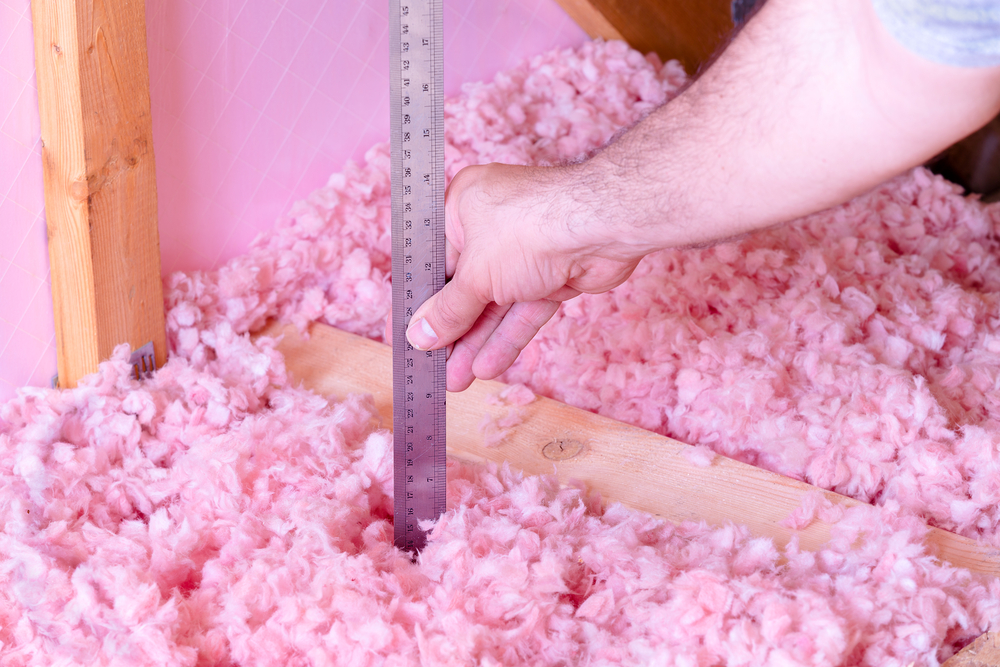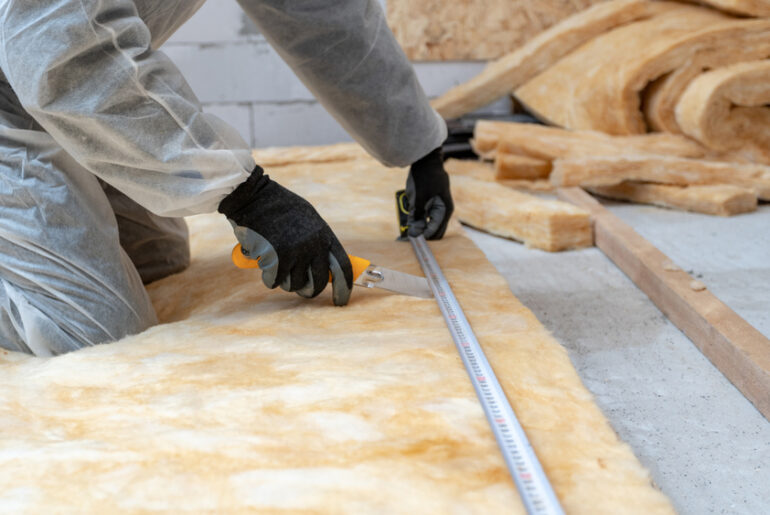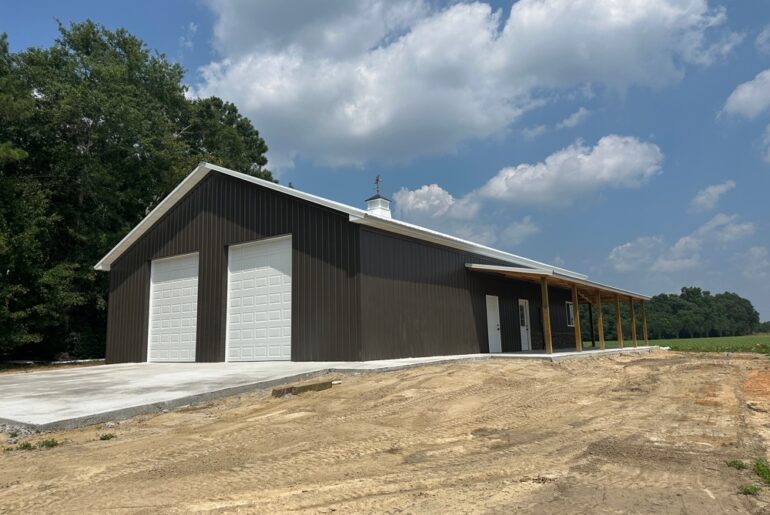Although loose-fill or blown-in fiberglass is a popular insulation technique, many homeowners are confused about its real R-Value.
The standard R-Value of loose-fill fiberglass is between 2.2 to 2.7 per inch. But factors like the insulation material’s depth, density, and installation process can affect its thermal performance. Even temperature, humidity, and moisture can affect fiberglass insulation’s thermal efficiency.
In this blog post, we will take a closer look at the true R-Value of blown-in fiberglass and how the mentioned factors affect its ability to reduce heat flow.
Let’s start.
Blown-in Fiberglass Insulation and Its True R-Value
Loose-fill, also known as a blown-in fiberglass insulation, is builders’ and homeowners’ most preferred method after batts and rolls. The installation process involves filling joist cavities and studs as well as covering attic floors by spraying any type of loose fiberglass insulation using a special blower. Because of its relatively efficient R-Value—or the ability to resist heat flow—loose fill fiberglass is often used in insulating areas like wall spaces and the attic.
Blown-in fiberglass has a standard R-Value of 2.2 to 2.7 per inch, according to the United States Department of Energy (USDOE ) and the Office of Energy Efficiency and Renewable Energy (EERE).
A loose-fill fiberglass’ thermal performance, however, changes depending on the material’s thickness. It varies and is influenced by several factors that can either increase, decrease, or eventually dissipate its ability to resist heat flow.
Factors that Affect The R-Value of Blown-in Fiberglass Insulation
Through our rigorous research, we find out that the R-Value of blown-in fiberglass insulation can be influenced by at least four factors. These are the space’s temperature, insulation depth, insulation density, and overblowing.
Here’s how the mentioned aspects influence loose-fill fiberglass’ ability to resist heat flow.
Temperature
In a study titled Thermal Performance of Fiberglass and Cellulose Attic Insulations and conducted at Oak Ridge National Laboratory, blown-in, cellulose, as well as batts and rolls of fiberglass insulation were tested to see how each material performs at varying temperatures.
The study found that the insulation material’s ability to resist heat flow changes depending on the temperature:
1. The material’s thermal performance improves generally as the attic gets colder.
2. Porous insulations like fiberglass showed a decrease in R-Value when the temperature gap between the conditioned space and the attic widens.
3. Batts and rolls and cellulose fiberglass experienced an increase in R-Value as the temperature dropped.
4. Light-density blown-in fiberglass insulation showed a slight initial increase as the attic’s temperature dropped but may eventually decrease as the temperature drops further.
Thus, low temperature can greatly affect blown-in fiberglass’ thermal performance due to convection within the insulation.
Further experimentation led the researchers to discover the use of covering layers. By covering the top of the material using a covering layer made of batt fiberglass with R-19 thermal resistance and polyethylene film combined with fiberglass blanket insulation, it stopped the reduction of loose-fill fiberglass’ R-Value.
Application and Coverage
Apart from temperature, other factors that influence loose-fill fiberglass insulation’s thermal performance are application and coverage. It is crucial to meet the required minimum thickness as well as the required minimum weight of a material per square foot to get the desired R-Value.
Loose-fill fiberglass’s thickness is commonly referred to as the insulation depth and insulation density. Both depth and density are important in achieving the desired R-Value.
Insulation Depth
Insulation depth is the amount of insulation material (loose-fill fiberglass, in this case) installed in a specific part of a house or building. And such a factor dictates the material’s R-Value and vice versa.
In the USA, house attic insulation has varying energy codes. Each code then requires a specific insulation depth—which is usually dependent on the area’s typical climate—to create optimal R-Value and achieve comfort well suited for the house. In Northeast California, for example, houses will need a higher insulation R-Value compared to those that are in the Southern part.
Aside from that, it may also differ for joist vaulted roof assemblies as well as attics and single rafters. The home’s age also plays a role in choosing the optimal insulation depth.
Insulation Density
In building and house insulation, density is the weight per unit volume of insulation material and is measured in kg/m3. And such a factor is crucial in fibrous insulation materials like blown-in fiberglass as it can directly influence the material’s thermal performance. Because as the material’s density increases, its R-Value increases as well.
Thus, higher density means higher R-Value.
The problem with blown-in fiberglass insulation, however, is that it can be fluffed up or made to look bigger and have met the depth requirement than what it truly is during the installation.
Such kind of practice is commonly known as overblowing and is also known as cheating. It is when installers unintentionally—and even intentionally—increase the air of the blowing machine and end up covering more than the intended size area. So while the insulation depth will be achieved, the density will be not. When this happens, the given R-Value needed will not be achieved as a result. Even lower heat resistance is also possible as the material settles over time.
Still, many homeowners are tricked into thinking that the insulation is providing the right R-Value.
Wetness and Excessive Humidity
Another factor that can significantly influence a blown-in fiberglass insulation’s R-Value is moisture. Wall leaks due to rain or gutter water are inevitable, especially if the masonry is substandard. And because blown-in fiberglass is a fibrous and hydrophilic material, it naturally absorbs and retains moisture.
When wet, loose-fill fiberglass’ R-Value degrades dramatically. Per North American Insulation Manufacturers Association (NAIMA), loose-fill fiberglass’ moisture vapor sorption shall not exceed the 5% mark by weight after. Rastra, a manufacturer of insulating concrete forms, also said that an increase of 1.5% in moisture content in the material reduces its ability to resist heat flow by 50%.
But that does not stop at that.
Because fibrous materials are hydrophilic, too much water content will eventually cause the material to dissolve. Hence, moisture can severely damage your house’s blown-in fiberglass insulation, reducing its R value down to zero.
Installation Errors
A poor installation process also affects a loose-fill fiberglass’ thermal performance. If it is compressed by plumbing or electrical lines, for example, the R-Value is reduced.
According to Rastra, blown-in fiberglass must be completely enclosed in all six sides of the cavity without any gaps and air pockets. Otherwise, its efficiency will be reduced. Usually between 20% to 50%.
Insulation with support beams, fittings, pipeworks, and other elements that are incorrectly installed can also affect the insulation material’s R-Value, which is why hiring a qualified and professional insulation installer is a must.
It is also the reason why loose-fill fiberglass is regarded as one of the most difficult insulation materials to install because of its meticulous process.
Age of Construction
Last but not least, the insulation’s material can also be affected by the age of construction. Wall leaks, for example, can destroy blown-in fiberglass insulation over time.
If you have bought an old house and noticed masonry issues, it is best to replace the existing insulation, especially if it is loose-fill fiberglass.
Loose-fill fiberglass itself can last up to 100 years and doesn’t degrade much if installed properly.
How Can You Increase R-Value of Your Blown-In Fiberglass Insulation?
To achieve your desired R-Value for loose-fill fiberglass insulation, it is crucial that you strictly follow the correct installation process of the insulation material to avoid unwanted outcomes that could negatively affect its thermal performance.
That said, below are a few tips to help you achieve and further increase the R-Value of Blown-In fiberglass insulation:
Hire A Professional Installer
Hiring a credible and professional insulation installer is the key to achieving your desired R-Value for your home. In fact, NAIMA advises homeowners to carefully select a contractor.
We already explained how poor installation can degrade the insulation material’s R-Value when even the smallest air pocket or gap can negatively influence its ability to resist heat.
However, blown-in fiberglass insulation also requires the use of a calibrated machine, which means only licensed and experienced workers can properly complete the job. Such workers can adjust the equipment too, as needed to further increase the insulation material’s R-Value. Installers must strictly follow the installation practices too, to make sure that the insulation’s performance is up to par.
Aside from that, overblowing or fluffing can also be done intentionally. Unfortunately, some installers do such practices. As such, it is crucial to hire credible and professional insulation installers only. Make sure that they can provide a receipt of all the measurements. It includes the initial installed thickness, the coverage area, minimum settled thickness, R-Value, and the number of bags used.
Box Off Recessed Can Lights And Electrical Cases
Although it does not necessarily increase the R-Value of loose-fill fiberglass, electrical cases and recessed can lights can relatively reduce it. As mentioned, it is important to leave no gaps or air pockets and must be enclosed completely. Otherwise, the efficiency of the insulation material will be reduced. The thing is, it would be difficult to do if there are obstructions with irregular shapes such as electrical wirings and cases.
As a solution, simply build a box around it. You can enclose it by simply a wallboard or scrap plywood.
Leaving electrical cases and recessed can lights can also pose electrical hazards, particularly old ones. Covering it with an insulation material may also lead to heat buildup and cause the light bulb to overheat prematurely.
Measure The Area First
The attic or area to be insulated must also be measured first. It allows installers to calculate the accurate amounts of insulation bags or pounds of insulation based on the bag level chart for the desired R-Value.
Such a step is important since, in order to achieve the desired R-Value, the correct number of bags of loose-fill fiberglass must be installed.
Avoid Insulation Compression
Based on an article published by Oak Ridge National Laboratory, insulation material that is compressed would not be able to provide its designated full rated R-Value. Such instances happen when a denser insulation product is added on top of lighter insulation material. A fiberglass batt on top of blown-in fiberglass, for example.
What’s The R-Value of Blown-In Fiberglass Insulation In Walls
Although loose-fill insulation is commonly installed in attics and crawl spaces, loose-fill fiberglass works well in walls too. It is especially handy for old houses without wall insulation.
The question now is, is blown-in fiberglass’ thermal performance the same as in the attic and crawl spaces?
Loose-fill fiberglass wall insulation works differently from attic insulation. It is specifically more confusing when figuring out the “real” R-Value.
In wall insulation, you will find two R-Values. These are nominal R-Value and effective R-Value. Nominal R-Value is the insulation value a material’s thickness can provide, while effective R-Value is the overall insulation value of the assembly.
Having said that, the R-Value of blown-in fiberglass in walls varies on the assembly itself. The effective R-Value of walls with framing that expands from the exterior to the interior is typically lower than the nominal R-Value. Such instances happen when heat is lost through the uninsulated frame and is called thermal bridging. Although it can be fixed by installing thermal breaks.
On the other hand, a wall with high thermal mass such as concrete and adobe has a higher effective R-Value than the measured or nominal R-Value. This phenomenon is due to the wall material’s ability to store heat. Although it only happens when certain conditions meet. Such as when the outdoor air or wall surface temperature is warm enough to transfer heat to the inside.
Walls with high thermal mass that are constantly exposed to the sun perform better compared to those that are not as well. Overall, it only suggests that temperature is a significant factor in how loose-fill fiberglass performs when installed in walls.
How Does Blown-In (Loose Fill) Fiberglass Insulation R-Value Compare to Fiberglass Batts and Rolls?
Loose-fill fiberglass insulation is relatively low in R-Value compared to batts and rolls. As mentioned, blown-in has an R-Value of 2.2 to 2.7 per inch only, while blanket insulation has an R-Value of 3.1 to 3.4 per inch.
Loose-fill performs poorly in colder climates too compared to batts and rolls. In fact, per the Oak Ridge study, batts and rolls R-Value increases significantly as the temperature drops further.
On the other hand, both insulation methods showed a decrease in R-Value when the temperature gap between the conditioned space and the attic widens.
Can You Put Too Much Blown-In Insulation in Your Attic?
As mentioned, the R-Value of loose-fill fiberglass can be influenced by the material’s thickness, density, as well as temperature. However, the thickness of the installed material is not a determining factor in whether it will perform well or not in terms of heat flow resistance.
To answer whether you can put “too much” amount of loose-fill fiberglass, the answer is YES. But for other reasons than density.
Having too much insulation may result in poor attic ventilation, and ultimately cause excessive condensation, inviting mold, and mildew growth. Another reason to avoid over-insulation is simply cost-efficiency. At some point adding more insulation simply won’t cause additional thermal benefits yet eat up a couple of extra bucks from your pocket.
In a house and building insulation, loose-fill fiberglass insulation must be installed based on the required thickness, density, coverage, and number of insulation bags. It is crucial for these factors to meet in order to achieve the desired R-Value.
The US Department of Energy (DOE) and International Energy Conservation Code (IECC) released a list of required levels of insulation for different climate zones which builders and homeowners may use. You can check the codes here.
Below is Owen Corning’s ThermaCube Plus for blown-in fiberglass insulation for your reference:
| R-Value | Minimum Bags per 1,000 sq. ft. | Maximum Coverage per Bag | Minimum Weight per Sq. Ft. | Minimum Thickness |
| R-49 | 25.0 | 40 | 0.878 | 19.50 |
| R-44 | 22.2 | 45 | 0.786 | 17.75 |
| R-38 | 19.2 | 52 | 0.676 | 15.50 |
| R-30 | 15.2 | 66 | 0.531 | 12.25 |
| R-26 | 13.2 | 76 | 0.459 | 10.75 |
| R-22 | 11.1 | 90 | 0.388 | 9.25 |
| R-19 | 9.5 | 105 | 0.334 | 8.00 |
| R-11 | 5.5 | 182 | 0.193 | 4.75 |
Sources:
- United States Department of Energy (USDOE) energy.wsu.edu
- Oak Ridge National Laboratory osti.gov
- North American Insulation Manufacturers Association (NAIMA) insulationinstitute.org





